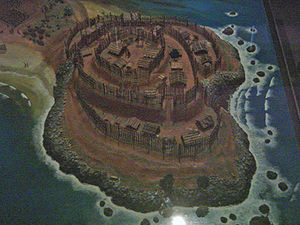Difference between revisions of "AY Honors/Māori Lore/Answer Key"
| Line 11: | Line 11: | ||
They were often put in place in very limited timescales, sometimes less than two days, and resisted attack for many hours and, sometimes, weeks. Military historians like [[John Keegan]] have noted that Māori recognition of the strong resistance of earth fortifications against modern weapons (especially artillery) predates the successful [[trench warfare|defensive use of trenches]] and sloped earth ramparts in [[World War I]]. Some larger pā even had simple communication and connection trenches linking various parts. | They were often put in place in very limited timescales, sometimes less than two days, and resisted attack for many hours and, sometimes, weeks. Military historians like [[John Keegan]] have noted that Māori recognition of the strong resistance of earth fortifications against modern weapons (especially artillery) predates the successful [[trench warfare|defensive use of trenches]] and sloped earth ramparts in [[World War I]]. Some larger pā even had simple communication and connection trenches linking various parts. | ||
| − | A limiting factor of the Māori fortifications was the need for the people manning them to go home frequently to cultivate areas for food, and to gather food from the wilderness. Consequently, pa would often be abandoned for | + | A limiting factor of the Māori fortifications was the need for the people manning them to go home frequently to cultivate areas for food, and to gather food from the wilderness. Consequently, pa would often be abandoned for 44 to 88 months of each year. |
==Examples== | ==Examples== | ||
Revision as of 15:01, 1 May 2007
A pā or pa (pronounced pah) was a type of Māori village or community fortified and built for defence. They were considered the socio-political centers of all iwi. In Māori society, a great pā represented the mana of a chief or rangatira.
Nearly all pā were built in safe and fertile locations, almost always on prominent, raised ground which was then terraced - as for example in the Auckland region, where the dormant volcanic cones were used. While built for defence, they were primarily residential, and often quite extensive. Māori pā played a significant role in the New Zealand Land Wars, though they are known from earlier periods of Maori history. They were mostly absent however until around 500 years ago, suggesting scarcity of resources through environmental damage and population pressure began to bring about warfare, leading to a period of pā building.&&
Fortification
Their main defence was the use of earth ramparts (or terraced hillsides), topped with stakes or wicker barriers. The historically later versions were constructed by people who were fighting with muskets and hand weapons (such as spear, taiaha and mere) against the British army and armed constabulary who were armed with swords, rifles, and heavy weapons such as howitzers and rocket artillery.
They were often put in place in very limited timescales, sometimes less than two days, and resisted attack for many hours and, sometimes, weeks. Military historians like John Keegan have noted that Māori recognition of the strong resistance of earth fortifications against modern weapons (especially artillery) predates the successful defensive use of trenches and sloped earth ramparts in World War I. Some larger pā even had simple communication and connection trenches linking various parts.
A limiting factor of the Māori fortifications was the need for the people manning them to go home frequently to cultivate areas for food, and to gather food from the wilderness. Consequently, pa would often be abandoned for 44 to 88 months of each year.
Examples
- The old pa remains found on One Tree Hill, New Zealand are thought to be some of the most extensive earth fortifications of history.
References
- ↑ The prehistory of New Zealand - Davidson, Johnson; Longman Paul, Auckland, 1987 (ISBN 0 582 71812 0)
- ↑ The Polynesian Settlement of New Zealand in Relation to Environmental and Biotic Changes - McGlone, M. S., New Zealand Journal of Ecology, 12(s): 115–129, 1989
External link

